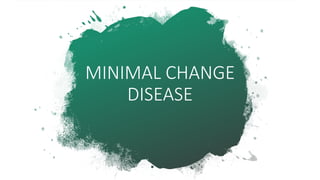Minimal change disease (MCD) is a common cause of nephrotic syndrome characterized by intense proteinuria. In children, MCD accounts for 70-90% of nephrotic syndrome cases. The disease is caused by abnormalities of the immune system resulting in foot process effacement and proteinuria. Treatment typically involves steroid therapy, which induces remission in most children within 8 days. However, relapses are common and additional immunosuppressive agents are often needed for frequent relapsing or steroid-dependent cases.







































